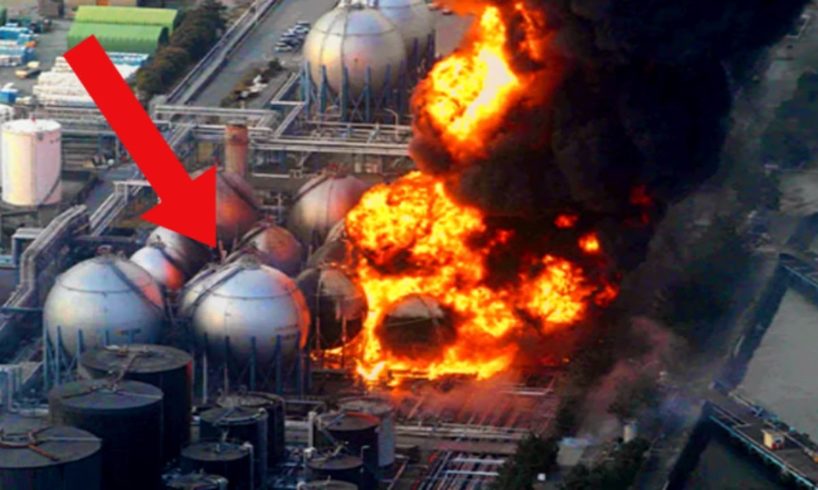
These are catastrophic engineering fails and disasters. Keep watching to see the worst and most unbelievable engineering disaster compilations
Subscribe to Talltanic: http://goo.gl/wgfvrr
Follow Talltanic’s Alexa Here: http://bit.ly/AlexaTalltanic
Watch Our MOST Popular Videos:
http://bit.ly/EvidenceAliensHAVEVisitedEarth
http://bit.ly/CRAZYIdeasThatActuallyWorked
http://bit.ly/UNBELIEVABLEItemsFoundAfterTsunamis
source







I was working for a radiation physicist when Chernobyl happened. He told me would happen to the area; he was so right.
Talltanic tales indeed…. "and the burning wooden frame of the Hindenburg". The frame was Duralumin, not wood. The chemical coating on the fabric skin was highly flammable, and burned faster than hydrogen. That's why the skin appears to burn off it before the rest burns. Do not recommend this channel.
Rubish! So much incorrect information.
You lost me with the irrelevant content and false information
13:46 – Rico Rodriguez!!!
I am surprised this does not have more thumbs down with the inaccurate use of photos. Most glaring, showing an oil refinery on fire as if it were part of the Fukushima Daichi reactor complex. Events left out: Deep Water Horizon; Piper Alpha; Grenfell Tower; Morandi Bridge.
The Hindenburg was not wooden framed. It had an aluminum frame.
You failed to mention it was raining when the Hindenburg was docking in NJ. I wonder just how many mistakes you made.
I have noticed that the research and photos for this channel is getting lax. Wrong dates misguided facts and wrong or irrelevant photos.
Think I'll unsubsribe.
The photographs are pathetic. If you cannot find accurate footage, don't cover the subject.
Can we say Fact Check?
Alexa, blow up my house.
Chernobyl's explosion was thermic, not nuclear, it just released contaminated material to the atmosphere… About Challenger, the designer told the NASA to delay the launch because of the freezing nights this week, but they refused because of the publicity of the event, so security was outclassed.
and bad dates!!!!!!!!!!!!!!!!!!!!!!!!!
not happy with old repeated photos. get better!
THUMBS DOWN!!! The Hindenburg did NOT have a wooden frame and it was certainly NOT a "Hot Air" ship. That's as far as I got before I decided this was another poorly researched or even NON-researched video.
The Hindenburg did not have a wooden frame. It was built of an Aluminum alloy.
OMG making the film flick is almost sending me in shakes, and I have no medical issues that would do that…. GEESh, I feel bad for the ones that do.
Thumbs down for all the errors in this video 👎👎
No mention of the Boston Molassacre? A large storage tank was built for molasses, based on a design for much lighter contents such as water. On 15 January 1919 it failed, killing 21, injuring 150 others, and inflicting extensive property damage.
Supposedly the O-Rings failed due to low atmospheric temperature. Sure. These were seals to the tanks of liquid propellant. Liquid hydrogen and liquid oxygen exist only at temperatures a bit lower than even an especially chilly Florida morning.
I will not correct the Fukushima Daichi presentation as it contains even more oversimplifications leading to errors in the explanation. I am sorry but it is true.
Tchernobyl is oversimplified! It is not that the control rods were withdrawn too much. It is that they were withdrawn because the power generated that was supposed to be held for a test between 700 and 1000 MW had dropped to 500 MW a technician INSERTS the control rods TOO FAR causing the power to drop to 30MW causing the release of a gas xenon 135 that inhibit the nuclear reaction. To try to restore the functioning thermal power to 500MW the technician then withdrew the control rods above the security limits. To increase the thermal exchange they increase the flow of water in the thermal exchanger. The test then begins causing the water flow to decrease, the water pressure to increase, bubbles to form in the primary liquid cooling system, the reactor to overheat causing the control rods to become deformed, and then the reactor is out of control and finally it explodes. The rest is history.
OK now to correct the errors on the Titanic comments. 1. The watertight compartments were NOT standard practice in shipbuilding of the time. 2. 6 not 5 compartments were compromised and thus flooded. 3. The report on brittle steel due to cold waters has been questioned time and again and remains controversial up to today. 5. What is accepted and proven by direct observation is the way the hull was compromised : rivets and hull plates were disjointed and torn on around 300 feet of the side of the hull. THIS is the cause of the quick sinking. The 6 compartments were compromised at once taking on water so fast that quickly the water started spilling over the transversal bulkheads. Then the bow started dipping and the water intake increased and increased… The one thing that all studies have proved is that should the Titanic have hit the iceberg head on, it most likely would have survived as no more than 1 or 2 watertight compartments would have been compromised. At the very least it could have survived long enough to be reached by other ships. Note that this disaster is what brought the regulations for lifeboats and also for double hulls, sealed watertight compartments etc.
OK, now for the Charles de Gaulle terminal collapse, It's not a problem of building strongly enough. It is the support structure of the collapsed section that was designed differently from the others due to 2 gangways that changed the efforts that the structure would be forced to endure. Due to the then innovation in shapes, engineers had to use 3d modeling to estimate the loads and compute the efforts. Problem, the estimates were not enough to compensate for the mounting methods that weakened part of the structure mostly the 3 arching beams pierced by struts. This combined with an extreme temperature contrasts on a 24h period caused the beams to expend and contract causing tears along the joints and causing the final collapse.
Hum sorry but the description for the hindenburg airship is completely wrong. The hydrogen was not from a fuel cell. The WHOLE hindenburg was actually filled with hydrogen instead of the planned helium because of the embargo on helium export to foreign countries by the sole producer the USA. Also the Hindenburg did not use hydrogen fuel cells for electricity. Although no definite conclusion was reached for the cause of the accident, the prevalent opinion is that static electricity combined with adverse weather conditions lead to sparks igniting pockets of hydrogen around the skin of the airship mostly around the 14 release valves used for maneuvers.
Number 16; 90% of the lives lost were native Americans and from one community, so 😥
I believe the Hyatt Regency took place in 1980 or 81
14 coment
Alexa call mom